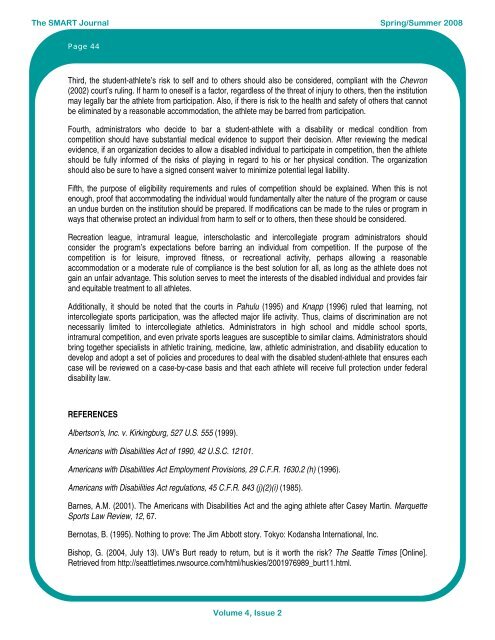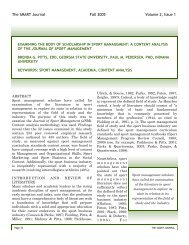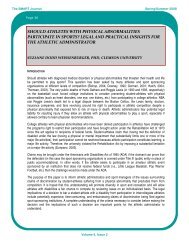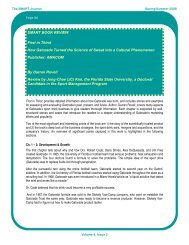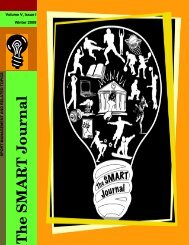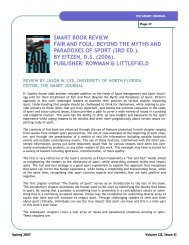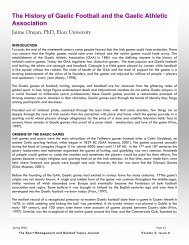Spring/Summer 2008 Volume 4, Issue 2 - The SMART Journal
Spring/Summer 2008 Volume 4, Issue 2 - The SMART Journal
Spring/Summer 2008 Volume 4, Issue 2 - The SMART Journal
You also want an ePaper? Increase the reach of your titles
YUMPU automatically turns print PDFs into web optimized ePapers that Google loves.
<strong>The</strong> <strong>SMART</strong> <strong>Journal</strong> <strong>Spring</strong>/<strong>Summer</strong> <strong>2008</strong><br />
Page 44<br />
Third, the student-athlete’s risk to self and to others should also be considered, compliant with the Chevron<br />
(2002) court’s ruling. If harm to oneself is a factor, regardless of the threat of injury to others, then the institution<br />
may legally bar the athlete from participation. Also, if there is risk to the health and safety of others that cannot<br />
be eliminated by a reasonable accommodation, the athlete may be barred from participation.<br />
Fourth, administrators who decide to bar a student-athlete with a disability or medical condition from<br />
competition should have substantial medical evidence to support their decision. After reviewing the medical<br />
evidence, if an organization decides to allow a disabled individual to participate in competition, then the athlete<br />
should be fully informed of the risks of playing in regard to his or her physical condition. <strong>The</strong> organization<br />
should also be sure to have a signed consent waiver to minimize potential legal liability.<br />
Fifth, the purpose of eligibility requirements and rules of competition should be explained. When this is not<br />
enough, proof that accommodating the individual would fundamentally alter the nature of the program or cause<br />
an undue burden on the institution should be prepared. If modifications can be made to the rules or program in<br />
ways that otherwise protect an individual from harm to self or to others, then these should be considered.<br />
Recreation league, intramural league, interscholastic and intercollegiate program administrators should<br />
consider the program’s expectations before barring an individual from competition. If the purpose of the<br />
competition is for leisure, improved fitness, or recreational activity, perhaps allowing a reasonable<br />
accommodation or a moderate rule of compliance is the best solution for all, as long as the athlete does not<br />
gain an unfair advantage. This solution serves to meet the interests of the disabled individual and provides fair<br />
and equitable treatment to all athletes.<br />
Additionally, it should be noted that the courts in Pahulu (1995) and Knapp (1996) ruled that learning, not<br />
intercollegiate sports participation, was the affected major life activity. Thus, claims of discrimination are not<br />
necessarily limited to intercollegiate athletics. Administrators in high school and middle school sports,<br />
intramural competition, and even private sports leagues are susceptible to similar claims. Administrators should<br />
bring together specialists in athletic training, medicine, law, athletic administration, and disability education to<br />
develop and adopt a set of policies and procedures to deal with the disabled student-athlete that ensures each<br />
case will be reviewed on a case-by-case basis and that each athlete will receive full protection under federal<br />
disability law.<br />
REFERENCES<br />
Albertson's, Inc. v. Kirkingburg, 527 U.S. 555 (1999).<br />
Americans with Disabilities Act of 1990, 42 U.S.C. 12101.<br />
Americans with Disabilities Act Employment Provisions, 29 C.F.R. 1630.2 (h) (1996).<br />
Americans with Disabilities Act regulations, 45 C.F.R. 843 (j)(2)(i) (1985).<br />
Barnes, A.M. (2001). <strong>The</strong> Americans with Disabilities Act and the aging athlete after Casey Martin. Marquette<br />
Sports Law Review, 12, 67.<br />
Bernotas, B. (1995). Nothing to prove: <strong>The</strong> Jim Abbott story. Tokyo: Kodansha International, Inc.<br />
Bishop, G. (2004, July 13). UW’s Burt ready to return, but is it worth the risk? <strong>The</strong> Seattle Times [Online].<br />
Retrieved from http://seattletimes.nwsource.com/html/huskies/2001976989_burt11.html.<br />
<strong>Volume</strong> 4, <strong>Issue</strong> 2


